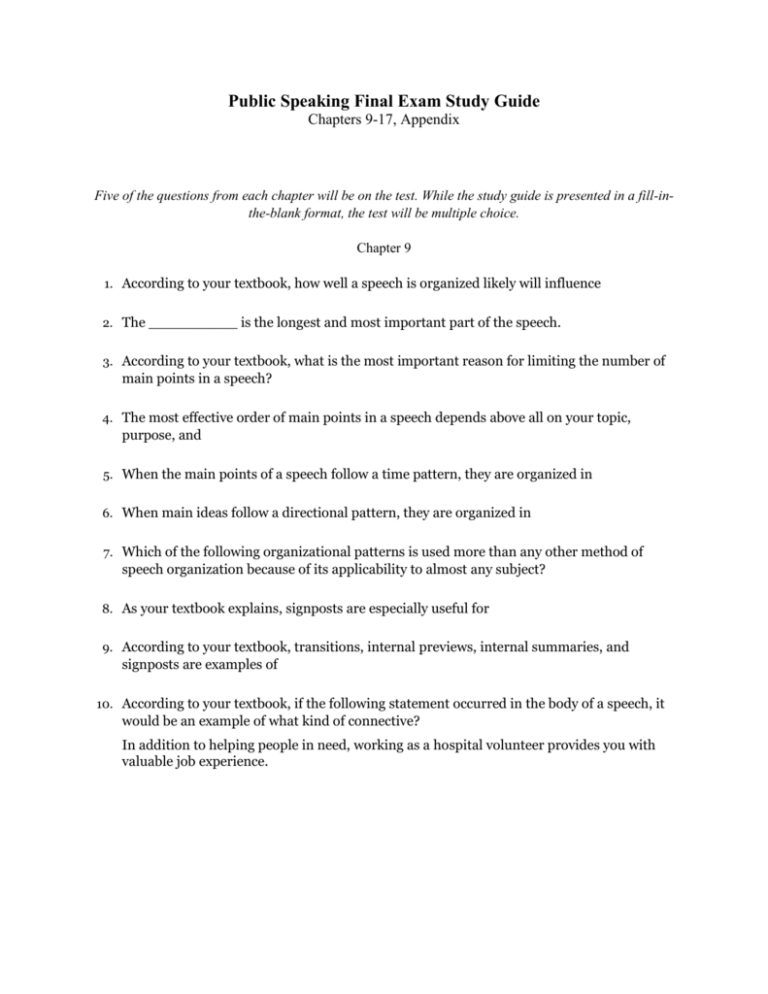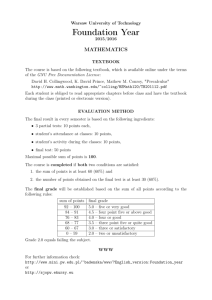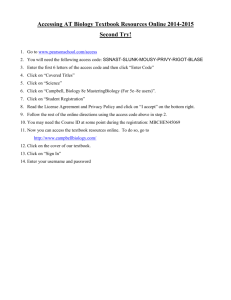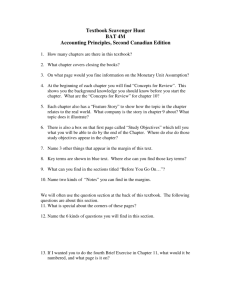Study Guide- Final Exam
advertisement

Public Speaking Final Exam Study Guide Chapters 9-17, Appendix Five of the questions from each chapter will be on the test. While the study guide is presented in a fill-inthe-blank format, the test will be multiple choice. Chapter 9 1. According to your textbook, how well a speech is organized likely will influence 2. The __________ is the longest and most important part of the speech. 3. According to your textbook, what is the most important reason for limiting the number of main points in a speech? 4. The most effective order of main points in a speech depends above all on your topic, purpose, and 5. When the main points of a speech follow a time pattern, they are organized in 6. When main ideas follow a directional pattern, they are organized in 7. Which of the following organizational patterns is used more than any other method of speech organization because of its applicability to almost any subject? 8. As your textbook explains, signposts are especially useful for 9. According to your textbook, transitions, internal previews, internal summaries, and signposts are examples of 10. According to your textbook, if the following statement occurred in the body of a speech, it would be an example of what kind of connective? In addition to helping people in need, working as a hospital volunteer provides you with valuable job experience. Chapter 10 11. All of the following are basic objectives of a speech introduction except 12. Which of the following would you most likely find in a well-constructed speech introduction? 13. Which of the following would you most likely find in a speech introduction? 14. __________ is the audience’s perception of whether the speaker is qualified to speak on a given topic. 15. When you advocate a highly unpopular position, it is particularly important to __________ in the introduction of your speech. 16. The best time to work out the exact wording of a speech introduction is 17. What does your textbook say about preparing an effective speech conclusion? 18. The conclusion of a speech is an appropriate time to 19. According to your textbook, a(n) __________ ending is a conclusion that builds force until reaching a peak of power and intensity. 20. A(n) __________ is most appropriate in the conclusion of a persuasive speech. Chapter 11 21. Outlining is important to public speaking because an outline helps a speaker 22. Two types of speech outlines discussed in your textbook are the 23. Which of the following should be included in a preparation outline? 24. According to your textbook, transitions, internal summaries, and other connectives should be 25. In a preparation outline, main points should be 26. According to your textbook, which of the following should be included in a speaking outline? 27. When preparing a speaking outline, you should 28. According to your textbook, the main reason to keep a speaking outline brief is to 29. As discussed in your textbook, delivery cues on a speaking outline may include 30. According to your textbook, in a speaking outline, the conclusion should be Chapter 12 31. Language helps to shape our sense of reality by 32. The denotative meaning of a word is 33. The connotative meaning of a word is 34. As a speaker, you would probably use more connotative words if you wanted to 35. According to your textbook, __________ words refer to ideas or concepts rather than to tangible objects. 36. To use language vividly, your textbook recommends that speakers employ 37. Phrases such as “dry as a bone,” “clear as a bell,” “dark as night,” and “smart as a whip” should be avoided in speeches because they are 38. “Memories are like fingerprints—no two sets are ever the same” is an example of 39. Your textbook recommends using repetition and parallelism to enhance the __________ of your speeches. 40. According to your textbook, “Let every nation know that we shall pay any price, bear any burden, meet any hardship, support any friend, oppose any foe to assure the survival and the success of liberty” is an example of Chapter 13 41. Communication based on a speaker’s body and voice, rather than on the use of words, is called 42. In which situation would a speaker be most likely to read from a manuscript? 43. In which situation would a speaker be most likely to recite a speech from memory? 44. According to your textbook, the __________ speaker delivers a speech with little or no immediate preparation. 45. The __________ speaker uses only brief notes or a speaking outline to jog the memory. 46. A speech that is fully prepared in advance but that is delivered from a brief set of notes or a speaking outline is called a(n) __________ speech. 47. According to your textbook, a speech that sounds spontaneous to the audience no matter how many times it has been rehearsed has a strong __________ quality. 48. “Conversational quality” in speech delivery means that the speech 49. The best rate of speech depends on the 50. According to your textbook, “uh,” “er,” “um,” and similar expressions in a public speech are referred to as Chapter 14 51. According to your textbook, which of the following is an advantage of using visual aids in a speech? 52. Visual aids are often helpful to a speaker because they can 53. If the object you want to use as a visual aid is not available, the next best option ideally is a 54. As your textbook explains, if you plan to use a photograph as a visual aid in a speech, you should usually 55. __________ are especially valuable for showing an audience statistical trends and patterns. 56. A __________ graph is best suited for illustrating simple distribution patterns. 57. If you wanted to demonstrate the comparative spending of the United States and Canada on four different kinds of social services, which type of visual aid would be most effective? 58. If you were giving a speech about how to execute basic karate moves, the best kind of visual aid to use would probably be 59. Which of the following does your textbook recommend for using visual aids? 60. According to your textbook, when you are going to give an audience material to take home from a speech, you should usually distribute the material Chapter 15 61. In an informative speech, the speaker acts as a(n) 62. According to your textbook, the aims of an informative speech include 63. According to your textbook, the questions listeners ask when judging an informative speech include 64. As explained in your textbook, “To inform my audience about the steps in creating a rooftop garden” is an example of a specific purpose statement for an informative speech about a(n) 65. As explained in your textbook, “To inform my audience about the causes of the American Revolution” is a specific purpose statement for an informative speech about a(n) 66. “To inform my audience about the major parts of a motion-picture camera” is a specific purpose statement for an informative speech about a(n) 67. Speeches about __________ are often more complex than other types of informative speeches. 68. Informative speeches about processes are usually arranged in __________ order. 69. Informative speeches about concepts are usually arranged in __________ order. 70. Which of the following is discussed in your textbook as a guideline for effective informative speaking? Chapter 16 71. Of all the kinds of speechmaking, __________ speaking is the most complex and the most challenging. 72. According to your textbook, persuasive speakers have an ethical obligation to 73. According to your textbook, persuasion is a psychological process in which listeners engage in a __________ with the speaker. 74. As your textbook explains, if you want to persuade a skeptical audience, you need to 75. The __________ is that portion of the whole audience that the speaker most wants to persuade. 76. The three types of questions that give rise to persuasive speeches are questions of 77. Persuasive speeches on questions of fact are usually organized in __________ order. 78. “To persuade my audience that long-term exposure to electromagnetic fields can cause serious health problems” is a specific purpose statement for a persuasive speech on a question of 79. Persuasive speeches on questions of __________ judge whether something is good or bad, right or wrong, fair or unfair. 80. Regardless of whether your aim is to encourage passive agreement or immediate action, you must deal with three basic issues whenever you discuss a question of policy. They are Chapter 17 81. What contemporary researchers term credibility, Aristotle termed 82. According to your textbook, the two most important factors affecting the credibility of a persuasive speaker are 83. According to your textbook, the credibility of a speaker at the end of the speech is called _________ credibility. 84. Evidence and reasoning are the two major elements of persuasion that Aristotle called 85. According to your textbook, using evidence in a persuasive speech can 86. When giving a persuasive speech to an audience that opposes your point of view, it is especially important that you use _________ to answer their objections to your views. 87. According to your textbook, a fallacy is 88. Appeals to audience emotions such as fear, compassion, guilt, or pride are the kinds of appeals that Aristotle referred to as 89. As your textbook explains, when using emotional appeal in a persuasive speech, you should 90. According to your textbook, the strongest source of emotional appeal in persuasive speaking is Appendix 91. T F Adding more slides to your presentation will show you know a lot about your speech topic. 92. T F You should spend approximately two minutes on each slide. 93. T F You should use fewer slides with more information on each slide. 94. T F When choosing a background image, you should select something exciting that will hold audience attention. 95. T F One of the most important factors in choosing a font is readability for the audience. 96. T F In order to retain audience attention you should incorporate sound into your slide transitions. 97. T F There is no functional difference between serif and sans-serif fonts in PPT. 98. T F 30 point font is the smallest size you should normally use in your presentation. 99. T F To determine the appropriate font size for your presentation, take the age of the oldest audience member and divide it by two. 100. T F Animating the text in your presentation will liven it up to add interest as well as credibility.




